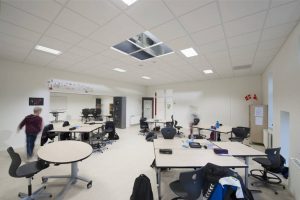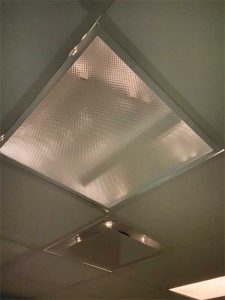By Gary Madaras, PhD, INCE, ASA, CAA, Assoc AIA

Building design standards and guidelines contain requirements for maximum permissible background noise levels in rooms due to the mechanical systems.1 A suspended acoustic ceiling is typically the only element between the noise-generating devices in the plenum and the people in the room below.
Specifiers and architects seeking to ensure the mechanical equipment noise does not exceed the ceiling system’s ability to attenuate it can use a straightforward method defined in the Air-Conditioning, Heating, and Refrigeration Institute’s (AHRI) Standard 885 (2008), Procedure for Estimating Occupied Space Sound Levels in the Application of Air Terminals and Air Outlets.2
It is always best acoustically, to locate noisy mechanical equipment away from sound sensitive rooms in which occupants need to concentrate, communicate, or relax. Placing a fan-powered box over a corridor is better than positioning it directly over the students inside a classroom. There are situations when placing noisy equipment over a sound-sensitive room is unavoidable. This does not need to result in angst. A simple and straightforward method of ensuring the suspended acoustic ceiling has the capability of attenuating the plenum noise
is laid out in AHRI Standard 885 as well as in the ASHRAE (formerly the American Society of Heating, Refrigerating and Air Conditioning Engineers) handbook HVAC Applications (2019).3
Building professionals that are not familiar with these standards or the prediction methods within them, may instead resort to specifying ceiling panels of a certain material type, minimum weight, or minimum ceiling attenuation class (CAC) rating. To understand why these approaches are inconsistent with the industry-accepted prediction methods, one must first understand how acoustic ceilings attenuate plenum noise.
Ceiling noise attenuation basics
A suspended acoustic ceiling system attenuates noise from inside the plenum in three ways.
Absorption: Noise from a mechanical device in the plenum reflects around inside the plenum and the room below. Ceiling panels with a noise reduction coefficient (NRC) of 0.90 or higher, absorb a lot of noise, inside the plenum and the room. This contributes to greater attenuation than when the ceiling panels have a lower NRC rating of 0.70 or less.

Malleable surface: The metal T-bar suspension systems, in which the acoustic ceiling panels are placed, are not completely flat. The grid flanges supporting the panels have high and low points. Rigid panels with hard surfaces rest on the peaks, creating gaps along the low points. Figure 1 shows how a bright light in the plenum and darkness in the room below reveals just how many noise leaks there can be. Panels made of soft material, such as stone wool, are malleable enough the material compresses at the high points and seals against the grid at the low points. Noise leaks between the panel face and grid flange are less likely.
The foundational ASHRAE research project (ASHRAE RP-755)4 leading to the prediction method in the ASHRAE handbook and AHRI standard concludes, “Experiments have shown that, for ceiling panels supported in a T-bar grid system, leakage between the panels and the grid is the major transmission path.”
Panel weight: Even if the ceiling panels have a high NRC rating and malleable surface, they also need sufficient mass/weight to keep the noise from easily passing through them. Per the ASHRAE handbook and AHRI standard, panel weight more than 2.4 kg/m2 (0.5 psf) provides no additional benefit, and panel weights as low as 0.5 kg/m2 (0.1 psf) only provide slightly less attenuation in the frequency bands of concern.
So which ceiling panels perform the best? Every ceiling panel performs better in some respects and worse in others. Some panels do not prevent noise leaks along the grid flanges, but they limit the noise passing through the panel itself. Other panels absorb the reflected noise in the plenum and room better and prevent noise leaks along the grid even though more sound passes through them. In conclusion, the ASHRAE handbook HVAC Applications, when discussing the attenuation performance of various ceiling panels, states, “Experiments have shown that, for ceiling panels supported in a T-bar grid system, differences among ceiling panel types are small.”




